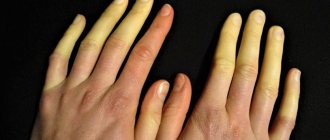Bulimia or kinorexia is a type of mental illness. It is based on an eating disorder expressed in the form of uncontrolled overeating. To relieve the consequences of excess food consumption, patients resort to the use of various compensatory mechanisms: they take laxatives, induce vomiting, and resort to heavy physical activity. Most of the life of patients is focused on their own attitude towards food, counting calories, analyzing their nutrition, and controlling body weight.
Bulimia: symptoms and treatment
Symptoms of bulimia
- Over a certain period of time (for example, within two hours), a person absorbs a large amount of food. The volume of food is much higher than usual. Up to 2.5 kilograms. The number of calories absorbed can exceed 5000 kcal.
- During such an attack there is a feeling of loss of control. A person cannot stop eating. Cannot control the quantity and quality of food consumed.
- Food restrictions apply. Great physical activity.
- The number of bouts of overeating is at least 2 times a week for 3 months. Compensatory behavior follows immediately after the end of the binge eating episode.
- Body weight and external parameters have a decisive impact on self-esteem. (DSM Ⅳ) and ICD-10)
There are 2 variants of the course of bulimia nervosa:
- With purifying behavior
- No purging behavior.
The first group is characterized by the use of fasting, self-induced vomiting, and the use of pharmacological drugs. For patients in the second group, weight maintenance through diets is typical. Group 1 is characterized by more severe dysmorphomanic disorders. In the future, their treatment becomes more difficult.
Diagnostics
Bulimia can be cured if the disease is identified in time. To make a diagnosis, it is enough for a specialist to pay attention to the presence of the above symptoms when talking with the patient. The attending physician knows what bulimia is and how it manifests itself, so the patient, first of all, is given psychological help.
In addition to reviewing behavioral signs, the doctor conducts differential diagnostics. It includes the exclusion of endocrine pathologies, diabetes mellitus, somatoform and dissociative disorders. When the symptoms of the disease are differentiated, the help of a psychotherapist is aimed at getting rid of the constant fear of gaining excess weight and feelings of hunger. The specialist uses various methods of influence to improve the quality of treatment for bulimia.
How is bulimia different from anorexia?
Both diseases under consideration are neurotic conditions in which the level of self-esteem directly depends on body weight. Eating disorders are observed in both bulimics and anorexics. The difference is that a bulemic person allows himself to eat, while an anorexic person does not. Negative emotions about excess weight lead a person with anorexia to exhaustion, and when he loses control over the situation, he loses weight to the point of starvation. According to statistics, 20% of anorexics die from exhaustion, heart failure or suicide.
Bulimia and anorexia
Bulimia is a type of anorectic behavior. At a certain stage of anorexia nervosa, a feeling of hunger that is difficult to overcome occurs. This is explained by the poor diet of an anorexic. Such hunger provokes overeating. In the future, fear, a feeling of heaviness in the stomach and anxiety about weight gain (or increase in volume) provoke him to cleansing behavior. That is, the links of one chain work: anorexia - diet - bulimia.
In anorexia nervosa, bulimic disorders are as follows (Korkina et al. 1991):
- Bulimia as a symptom of anorexia nervosa
- Bulimia as a stage of anorexia nervosa
- Bulimic variant of anorexia nervosa
Bulimia as a symptom of anorexia nervosa
only limited to attacks of irresistible hunger (paroxysmal increase in appetite). This is a symptom of a worsening disease due to limited nutrition (0-300 kcal/day). Fear and anxiety of weight gain (the central pathology of anorexia and bulimia) prevents excessive eating. Next comes constant thoughts about food, uncertainty about refusing food. (Obsessive-phobic symptoms). If a diet lapse occurs, which manifests itself in a bulimic attack (overeating), the result is heaviness in the stomach, nausea, and spontaneous vomiting. Later, during such bulimic attacks, a person resorts to self-induced vomiting.
Bulimia as a stage of anorexia nervosa
– attacks of hunger and all of the above turns into a pattern of constant behavior. At the same time, the amount of food eaten (or rather, absorbed food) gradually increases. Before an attack there is a feeling of anxiety and restlessness. If there are obstacles to satisfying hunger, then aggressive tendencies arise. The process of overeating itself is accompanied by euphoria. Autonomic reactions after overeating manifest themselves in heaviness in the stomach (due to stretching of its walls by excessive amounts of food). But fear of weight gain leads to self-induced vomiting and the use of large amounts of laxatives. Body weight may be low, but during a protracted bulimic stage it begins to increase.
There are cases when bulimic attacks do not lead to self-induced vomiting. Then the state of euphoria is replaced by increased anxiety and depressive symptoms. In the future (depending on the severity of the mental pathology), aggressive manifestations towards loved ones may appear. Agitation (motor restlessness with emotional agitation, anxiety and fear) and suicidal intentions may also occur. These abnormalities may also accompany long-term cases of most eating disorders.
A vicious circle is formed when bulimia attacks occur against the background of depressive symptoms. Which in turn leads to increased depression. At this stage, a gradual change in personality occurs. Irritability appears, and aggressive actions may be committed (explosiveness traits). Anxious and suspicious traits are added.
Bulimic variant of anorexia nervosa
manifests itself in a clear distinctive characteristic. Correction of appearance through food restrictions lasts from several weeks to six months. In this case, bulimic symptoms and pathological forms of eating behavior very quickly develop. Next, they determine the clinical picture of the disease. In this case, the stage of food restriction is mandatory. But hunger is very difficult for such a person. Premorbidly, these may be people with somatoendocrine insufficiency and a tendency to be overweight. For women, irregular menstrual cycles are common.
The difference between the bulimic form of anorexia nervosa and bulimia is amenorrhea and weight loss. To distinguish bulimia from disorders of the gastrointestinal tract, one must remember that vomiting in the second case is involuntary.
Classification
It is customary to distinguish two types of bulimia:
- primary – characterized by a constant feeling of hunger, an irresistible desire to consume food at any time of the day, followed by a deep feeling of guilt and attempts at cleansing;
- secondary, resulting from anorexia and being one of its symptoms.
The disease can occur in two ways:
- with the use of cleansing methods such as enema, inducing vomiting, taking laxatives and diuretics after attacks of gluttony;
- through fasting and diets, the cessation of which leads to gluttony.
Causes of bulimia
There are several types of causes of bulimia:
- Organic
- Psychogenic
- Social
Organic causes - endocrine disorders. These also include diseases in which bulimic attacks appear as a symptom of injuries and tumors of the brain (hypothalamic-pituitary region). For diabetes, for stroke.
Bulimic attacks can be signs of mental pathology: depression, schizophrenia.
Psychogenic causes –
- psychological trauma (possible even in childhood),
- lack of nutrients (with dieting and often with anorexia)
- low self-esteem
- perfectionism
Social reasons are the need to meet the standards of slimness imposed in society. In addition, in adolescence there is a negative assessment from peers of appearance in the case of being overweight. Or, on the contrary, in the case of excessive thinness, criticism and rejection also manifests itself.
The family atmosphere can also be a source of the problem. Pressure from parents and lack of love can provoke the manifestation of the disease.
Why does it appear?
Eating disorders are a complex problem; they are always based on several factors: physiological, social and psychological. The following reasons can provoke such a disorder:
- Heredity (tendency to be overweight, hormonal disorders);
- Impaired functioning of the brain (receptors responsible for the feeling of satiety are damaged);
- Low self-esteem and complexes;
- Social pressure (“everyone loves slim people”, “you can’t eat too much”);
- Stressful situations or psychological trauma.
Modern food only adds temptations and increases the risk of developing an eating disorder: all kinds of flavorings, sweeteners and the ubiquitous taste enhancer monosodium glutamate only stimulate appetite. It is very difficult to get enough of such food, and the body, “hooked” on food chemistry, demands more.
Signs of bulimia
- Overvaluation of slimness (concern with one's own weight, appearance)
- Grueling sports activities
- Mood instability (depression, irritability, anxiety)
- Weakness due to hypotension (low blood pressure)
- Arrhythmia (heart dysfunction)
- Vomiting blood. This is a manifestation of cracks in the walls of the esophagus.
- Swelling of the face and throat
- Scratches and scars from cuts on the upper incisors with constant self-induced vomiting (Russell's sign)
- Caries and gradual tooth decay
- Hemorrhages in the sky
- Petechiae (red streaks) on the face after vomiting
- Red eyes due to vasodilation of the eyeball after vomiting
- Hemorrhoids due to increased stress on the intestines and rectum due to excessive use of laxatives
- When using diuretics, changes in blood pressure and dehydration of the body.
- Deterioration of reproductive function. Decreased libido and potency. Women have complications with conception and pregnancy.
Clinical picture
As I already said, it is quite difficult to suspect a person of bulimia, because his appearance and behavior, as a rule, do not arouse suspicion among others. It is unlikely that you will be able to recognize a person with bulimia in a photo or video, although this disease is very common among public people.
Typically, such patients have normal body weight, sometimes with slight fluctuations upward, and in society they do not show any particular weakness for food, sometimes even limiting themselves in food.
Bulimics consider their attacks shameful and keep this secret deep inside themselves, only occasionally devoting their closest people to their secret. And the further they delve into the disease, the more withdrawn they become: communication with other people fades into the background, food is elevated to a cult, and food addiction arises.
Symptoms
However, there are a number of characteristic signs to identify a person with this disorder. The behavior of people suffering from the disease is characterized by:
- Hasty eating, swallowing pieces without chewing, eating large amounts of food.
- After eating, go to the toilet to cleanse your body of what you just ate.
- Changing your lifestyle to a secluded and secluded one.
- Unhealthy obsession with diets, calorie counting and alternative ways to lose weight.
- Demanding on yourself.
From a physiological point of view, the following changes occur in the body of bulimics:
- Hypertrophy of the salivary glands.
- Swelling of the glands on the face and neck.
- Frequent general malaise and weakness.
- Hemorrhages on the face.
- Destruction or discoloration of tooth enamel (due to stomach acid in vomit).
- Damage to fingers (also due to inducing vomiting).
- Sore throat, tendency to inflammatory diseases of the pharynx.
- Inflammation of the esophagus.
- Changes in weight.
- Failure of the menstrual cycle.
- Metabolic disorders.
If you notice isolated symptoms from the description of the disease in yourself or your loved ones, this does not indicate the presence of bulimia. It is possible to talk about a disease only if there is a complex of symptoms.
At risk, just like with anorexia, are primarily girls aged 13 to 27 years. It is not without reason that doctors separately identify teenage bulimia, which develops during the period of hormonal changes, when adolescents are especially unstable psychologically.
Consequences of bulimia
- Destruction of tooth enamel, and as a result – caries. When exposed to hydrochloric acid not only on the teeth, but also on the gums, gingivitis appears - inflammation of the gum tissue. Periodontitis, an inflammation of the periodontium, can also occur. This means inflammation of the connective tissue between the tooth and the alveolus. Due to frequent bouts of vomiting, inflammation of the parotid glands may develop.
- Digestive system: diseases of the esophagus, stomach and intestines appear. Esophagitis is inflammation of the esophageal mucosa. Manifests itself in a feeling of coma and pain. The cardiac sphincter, which separates the esophagus from the stomach, may be impaired. In this case, the contents of the stomach enter the esophagus. Due to the high content of hydrochloric acid, irritation of the walls of the esophagus occurs. This can further lead to ulcerations on the mucosal surface.
- An esophageal diverticulum is a pouch-like protrusion of the wall of the esophagus. It manifests itself as a result of prolonged inflammatory processes in the superficial and deep layers of the esophagus. Manifests itself in difficulty swallowing food. In addition, there is retention and accumulation of food in these parts of the esophagus. Subsequently, it begins to decompose, which leads to a specific smell. In long-term cases, it can result in thinning of the walls of the esophagus and perforation - rupture.
- The muscle ring that separates the stomach from the duodenum may also become damaged. That is, the pyloric sphincter. Then bile elements and pancreatic enzymes enter the stomach. This leads to poor digestion of food. During vomiting, they can reach the esophagus along with gastric contents.
- Hyperacidity is a common symptom of bulimia. It develops because during a bulimic episode a large amount of food enters the stomach. Then a large amount of gastric juice containing hydrochloric acid is secreted reflexively. After vomiting and partial removal of food from the stomach, hydrochloric acid continues to be released for some time and affects the walls of the stomach. This leads to gastritis.
- When a bolus of food with an increased content of hydrochloric acid passes from the stomach to the intestines, it affects the intestinal mucosa. Multiple ulcers form. Often such intestinal damage gives rise to an erroneous diagnosis of Crohn's disease.
- With such changes in the digestive process, the intestines also suffer - peristalsis is disrupted, the composition of the microflora and the reaction of the environment (from alkaline to acidic) may change. The consequence of this is dysbacteriosis. Inflammation of the intestines – colitis – can also develop.
- With the constant use of laxatives to remove excess food from the gastrointestinal tract, firstly, dehydration of the body occurs. Secondly, due to the increased load on the rectum - hemorrhoids.
With prolonged exposure to unfavorable factors on the body, a transition to cancer can occur.
- The electrolyte balance is disturbed. There is a lack of potassium, calcium, sodium, and chlorine in the body. This can cause disruption of the heart muscle. This may manifest itself as tachycardia and shortness of breath. For the body as a whole, this is accompanied by weakness.
- Reproductive function also suffers. The level of female hormones decreases, the menstrual cycle is disrupted. During pregnancy, fetal development is disrupted due to metabolic disorders in the mother.
- The structure of hair and nails is damaged. Skin may become dry due to dehydration. Nails may peel and hair may begin to fall out.
- In addition to pathological changes in the body itself, there is a deterioration in the inner world of a person. This manifests itself in increased depressive symptoms, limited contacts, and a feeling of constant guilt and inferiority. Interests may be sharply limited to food topics. The whole world narrows down to the path from the table to the bathroom.
- With a long course of bulimia, depending on personal characteristics, alcohol and drug dependence may occur. This occurs as a search for ways to free yourself from a depressive reality. There is also an opinion that bulimic attacks themselves may be a manifestation of escape from reality into the world of food pleasure. That is, it manifests itself as food addiction.
- In the most severe cases, nervous breakdowns and suicidal intentions are possible. In such cases, it is necessary to provide specialized care in a hospital setting.
Forecast
If you or someone you love has symptoms of bulimia, consult a doctor. This disease is dangerous because the patient is absolutely unable to control himself, and ultimately bulimia can acquire a severe form. Various disorders resulting from the disease are reversible with an integrated approach to treatment.
In the case of bulimia, the prognosis is related to the effectiveness of the treatment and the psychological mood of the patient. With timely, effective medical therapy and high-quality psychocorrection, the prognosis is favorable. Otherwise, complications may arise in the form of disruption of the cardiovascular system, stomach problems or a depressed psyche.
In some cases, spontaneous healing may occur. For example, with a powerful positive mental shock and a change in the patient’s psychological state for the better.
In order to prevent the appearance of bulimia, prevention is necessary, which consists of maintaining a healthy psychological climate in the family, instilling proper nutrition skills in the child and developing adequate self-esteem. If a teenager is worried about figure flaws and excessive obesity, it is necessary to monitor his diet and eating behavior. Food should not be used as a means of rewarding or punishing children.
Practice shows that attempts to cure this disease on your own do not lead to tangible results: sooner or later there comes a time again when you can’t restrain yourself and attack food. It will be quite difficult to achieve progress in this case. With the help of professionals and the support of relatives, coping with bulimia will be much easier. The main condition for recovery: no need to overeat or starve. Nutrition should be balanced, and a positive emotional state should be stable.
How to treat?
If you suspect that you have bulimia nervosa, treatment should be started immediately: this will save your nerves, health and money. In later stages, complex therapy is necessary:
- Conversations with a psychotherapist;
- Therapeutic diet;
- Treatment of affected organs is mandatory! – teeth;
- Taking multivitamins and antidepressants;
- Physiotherapy.
How to treat such a mental disorder yourself and is it possible to cope with attacks of the disease at home? Everything is real, the main thing is the support of family and friends. It is the family that will help protect you from unnecessary stress, regain faith in yourself, and love your own body for what it is. And it is the relatives who will check whether the girl is following a therapeutic diet and will not allow her to relapse again.
Types of Eating Disorders
In search of an answer to the question of what bulimia is, scientists have developed many classification schemes for this disease: according to the mechanism of occurrence, according to the method of cleansing the body, according to variants of vomiting behavior, etc. But most experts distinguish 2 main classifications of this pathology.
According to the first scheme, there is a classic or purging eating disorder (eating, then vomiting, laxative or enema), and a second stage of bulimia. With this form, patients do not try to cleanse the body of the tasty treats they eat every time, but alternate bouts of gluttony with sports training and hunger strikes. Both the relatively healthy kefir or watermelon diet for 3 days and dangerous dry fasting are used...
Other experts distinguish between traditional nervous eating disorders (women 25-35 years old) and pubertal ones (teenagers and young girls). The cause of mental failure is constant stress, problems in personal life, low self-esteem, and the influence of model beauty standards.











